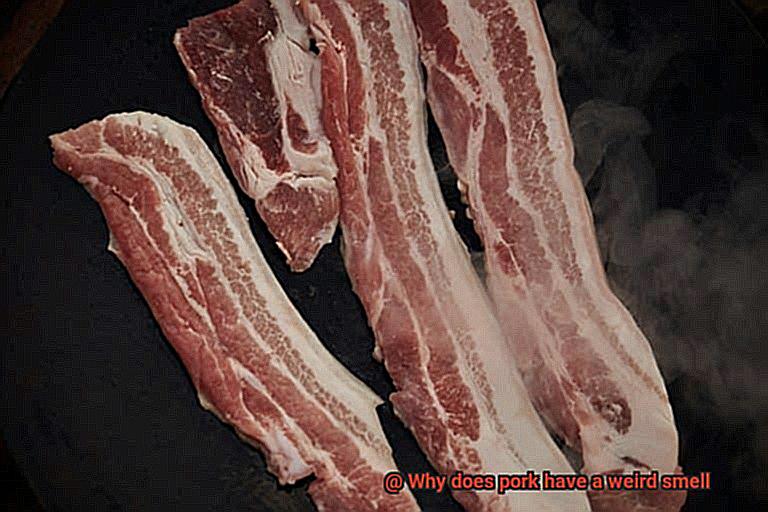Have you ever cooked pork and noticed its distinct smell? It’s hard to describe, but some say it smells earthy, while others describe it as musky or gamey. Regardless of how you put it, the smell of pork is unique and unmistakable. But why does pork have such a weird smell?
As someone who loves cooking pork, I became curious about this myself. So, I did some digging and discovered some surprising and fascinating facts about what causes this odor.
In this blog post, I’ll be taking you on a journey to explore the reasons why pork has a weird smell. From the pig’s diet to its living conditions, there are many factors that can affect the flavor and aroma of pork. Plus, I’ll provide tips on how to properly store and prepare pork to minimize its odor.
So if you’re interested in learning more about the science behind the smell of pork or simply want to up your pork-cooking game, keep reading. This article could change everything you thought you knew about cooking with pork.
Contents
Compounds that Cause the Odor of Pork
Pork is a beloved meat enjoyed by all, but it’s not uncommon for some people to find its distinct scent a little off-putting. The truth is, the unique odor of pork is attributed to specific compounds that are present in the meat. Of these compounds, skatole and androstenone are two of the most prominent.
Skatole is a naturally occurring compound that can be found in the intestines of animals, including pigs. When pork is cooked, skatole can be released and contribute to the distinct odor of pork. Skatole has a strong, unpleasant smell that is often described as fecal or barnyard-like. However, it’s important to note that not all pork will have a strong skatole odor as animal diet and processing methods can impact its presence.
Androstenone is another compound found in male pigs that can contribute to the smell of pork. This compound is produced in the testes of male pigs and can be present in meat from male pigs that have not been castrated. Androstenone has a musky, urine-like odor that can be off-putting to some people.
It’s worth noting that not all pork will carry an unpleasant odor. Proper handling and preparation are key factors in ensuring that pork smells and tastes delicious. Additionally, factors such as animal diet and processing methods can impact the odor and flavor of pork.
When selecting pork, it’s important to look for fresh cuts that are properly stored at the correct temperature. Cooking techniques can also impact the odor and flavor of pork. Avoid cooking pork at high temperatures for too long as this can cause it to become dry and develop an unpleasant smell.
How Diet Affects the Smell of Pork
Then pay attention, because the diet of pigs plays a vital role in the smell of their meat. As an expert in all things pork, let me break it down for you.
Firstly, pigs are omnivores, meaning they consume both plant and animal-based foods. Hence, their varied diet can significantly impact the taste and scent of their meat. Garlic and onion-based feeds are known to result in a stronger odor in pork. So, if you’re not a fan of overpowering smells, steer clear of these types of feeds.
Secondly, the type of feed given to pigs and the manner of feeding can also affect the smell of their meat. Pigs that forage for food outdoors tend to have a milder scent compared to those raised indoors and fed commercial feeds. Additionally, some farmers may feed their pigs with corn or soy-based diets, resulting in sweeter smelling pork.
Lastly, some farmers add antibiotics to pig feed to prevent diseases or promote growth. While this practice may be beneficial for the pigs’ health, it can also impact the smell of their meat. Therefore, it’s essential to consider the use of antibiotics when selecting pork.
Impact of Raising Conditions on the Smell of Pork

If you’ve ever wondered why some pork has a strong and unpleasant odor while others have a milder, sweeter fragrance, wonder no more because I’ve got all the answers for you.
Firstly, pigs raised in clean, spacious environments with a healthy diet tend to produce meat with a milder odor compared to those raised in cramped and dirty conditions. Can you imagine living in your own waste? That’s exactly what poorly raised pigs do, leading to bacterial growth and infections that cause the pig’s meat to develop an unpleasant odor that some people describe as “gamey” or “sour.”
In addition to living conditions, the feed given to pigs can also contribute to the smell of their meat. Pigs fed on a diet including corn, soybeans, and other grains tend to produce meat with a milder odor compared to those fed on a diet heavy in fishmeal or other strong-smelling ingredients. What pigs eat plays a significant role in the quality of their meat.
It’s worth noting that how pigs are slaughtered and processed can also affect the smell of their meat. If not handled correctly, the meat can become contaminated with bacteria or other harmful substances that cause an unpleasant odor.
To ensure you’re consuming the best quality pork, choose from reputable sources that prioritize humane and sanitary raising conditions. Not only does it ensure better-tasting meat, but it also supports ethical animal welfare practices.
In summary, here are some key takeaways:
- Clean and spacious environments lead to milder smelling pork
- A healthy diet including grains results in better quality pork
- Slaughter and processing methods impact odor
- Choose pork from reputable sources to support ethical animal welfare practices

Processing and Storage Factors that Affect the Smell of Pork
You may not have known that processing and storage factors can play a crucial role in determining the scent of your meat. Let’s dive into how these factors can affect the odor of pork.
First, let’s talk about processing. The pig’s diet, age, and breed can all impact the smell of pork. Pigs fed with specific types of feed may produce meat with a stronger odor than those fed on a diverse diet. Additionally, older pigs tend to have a stronger odor than younger ones. Certain breeds, such as Berkshire and Duroc, are known for their distinctive aroma. Make sure to be mindful of these factors when purchasing your pork.
However, storage conditions are equally as important in determining the scent of your pork. Storing pork at high temperatures or for an extended period can result in an unpleasant smell. Oxidation caused by exposure to oxygen during storage can lead to rancidity and an off-putting odor. Even the packaging used to store pork matters. If pork is wrapped in plastic packaging that is not air-tight, it can absorb odors from other foods in the fridge or freezer, leading to an unpleasant smell.
To ensure that your pork smells fresh and appetizing, consider buying from reputable sources that prioritize humane and sanitary raising conditions. Pay attention to storage conditions – keep your pork at a low temperature and use air-tight packaging. And always trust your senses – if your pork smells off, it’s better to be safe than sorry and throw it out.
Common Cuts of Meat with a Stronger Odor
Let’s explore the reasons behind the pungent aroma of some common pork cuts.
Firstly, cuts like shoulder, belly, and hocks tend to have higher fat and connective tissue content, which contributes to the flavor and texture of the meat. However, it also means that the fat can release a more pronounced aroma during cooking. If you’re sensitive to strong scents, you may find these cuts less appealing.
Another factor that can contribute to a stronger smell is the aging or storage of the meat. During the aging process, proteins and fats break down naturally, which can intensify the scent. Similarly, if the meat is not stored correctly or for extended periods of time, this can also lead to a stronger odor.

But fear not. Just because these cuts may have a stronger odor doesn’t mean they’re unsafe to eat. Proper storage and cooking techniques can help reduce any unpleasant smells and ensure that the meat is safe for consumption. So don’t let the scent deter you from trying these flavorful cuts.
However, if you prefer a milder taste or are sensitive to strong odors, there are still plenty of options available. Leaner cuts such as loin or tenderloin have a milder flavor and aroma, making them a great choice for those who prefer subtler tastes. Plus, when cooked correctly, they can be just as delicious as the more robust cuts.
Tips to Reduce Unpleasant Odors in Pork
Pork is a versatile meat that can be used in a variety of dishes, but the unpleasant odor that sometimes accompanies it may put you off. Here are some tips to help reduce the smell of pork and make it more enjoyable:
Buy Fresh Pork
When buying pork, make sure it is fresh and of good quality. Choose meat that is light pink in color and has a mild odor. Avoid pork that looks grayish or has a sour smell, as these are signs of spoilage.
Proper Handling
Handling pork properly is essential to prevent the spread of bacteria and reduce unpleasant odors. Wash your hands before and after handling raw pork, and use separate cutting boards and utensils for raw meat.
Store Properly

Proper storage is key to reducing unpleasant odors in pork. Store it in the refrigerator at temperatures below 40°F and use it within 3-5 days. If you are not going to use the pork within this timeframe, consider freezing it for later use.
Marinate the Meat
Marinating pork can help to reduce unpleasant odors and improve flavor. Choose a marinade that contains acidic ingredients like vinegar or citrus juice, as these can help break down the proteins in the meat and make it more tender.
Cook Thoroughly
To eliminate any harmful bacteria and reduce unpleasant odors, cook pork thoroughly until it reaches an internal temperature of at least 145°F. Use a meat thermometer to ensure accuracy.
Health Benefits of Eating Pork Despite its Unique Smell
Despite its unique smell, this popular meat offers a range of health benefits that make it a nutritious addition to your diet. As an expert in the field, I am here to share with you the many reasons why you should consider adding pork to your plate.
First and foremost, pork is an excellent source of protein. In fact, a 100-gram serving of pork provides about 25 grams of protein, making it an ideal choice for individuals looking to increase their protein intake. But that’s not all. Pork also contains essential amino acids that are crucial for building and repairing muscles and tissues in the body.
Not only is pork rich in protein, but it’s also packed with vitamins and minerals that are essential for maintaining optimal health. Thiamin, niacin, vitamin B6, and phosphorus are just a few of the key nutrients found in pork that support energy production, nerve function, brain development, immune function, healthy bones and teeth, and kidney function.
But what about fat? Contrary to popular belief, lean cuts of pork contain relatively low amounts of saturated fat and cholesterol compared to other meats like beef or lamb. For instance, a 100-gram serving of pork contains about 3.5 grams of saturated fat, which is less than half the amount found in the same serving size of beef. Additionally, pork is also high in monounsaturated and polyunsaturated fats that can help lower levels of LDL cholesterol (the “bad” cholesterol) in the blood.
How to Cook and Prepare Pork for Maximum Taste and Aroma
Pork is a delicious and versatile meat that can be prepared in various ways. However, without proper preparation, it can result in an unpleasant smell and taste. Here are six tips to help you cook and prepare pork for maximum taste and aroma.
Choose the Right Cut
Different cuts of pork have varying levels of fat content, which can affect the overall flavor and texture of the meat. It’s essential to choose a cut that is appropriate for the dish you want to make. For example, a pork shoulder is ideal for slow-cooking methods like braising or roasting, while leaner cuts like pork tenderloin are best for grilling or broiling.
Properly Season the Pork
Before cooking, it’s crucial to season the pork with spices and herbs to add flavor and mask any potential weird smells. Additionally, marinating the pork in a mixture of acid, oil, and seasonings can help to tenderize the meat and infuse it with flavor. A basic marinade consists of oil, acid (vinegar or citrus juices), and seasonings (garlic, onion, herbs).
Use the Right Cooking Method
The cooking method you choose will depend on the cut of meat you are using. Slow-cooking methods like braising or roasting are best for tougher cuts, while grilling or broiling is ideal for leaner cuts. When cooking pork, it’s important to use the right cooking temperature and time to ensure that it’s cooked thoroughly but not overcooked.
Cook to the Appropriate Temperature
Cooking pork to the appropriate temperature is essential for safety and flavor. Overcooking can result in dry, tough meat while undercooking can lead to foodborne illness. The USDA recommends cooking pork to an internal temperature of 145°F followed by a three-minute rest time before serving.
Allow Pork to Rest Before Serving
Allowing cooked pork to rest for a few minutes before slicing or serving allows the juices to distribute evenly throughout the meat, resulting in a more flavorful and juicy dish. Cover the cooked pork with a foil and let it rest for 5-10 minutes before slicing it.
Pay Attention to Freshness
Selecting fresh pork is crucial in avoiding a weird smell. When purchasing pork, ensure that it has been stored at the right temperature and displayed correctly in the store. Avoid meat that has been sitting in the refrigerator for too long as it can develop an unpleasant smell.
12TRWYf2T5U” >
Conclusion
In conclusion, the distinct aroma of pork can be attributed to a variety of factors. Skatole and androstenone are just two of the compounds that contribute to the unique smell of this meat. The pig’s diet, living conditions, processing methods, storage techniques, and cut of meat also play a role.
While some may find the scent off-putting, proper handling and preparation can help reduce any unpleasant odors. It’s crucial to select fresh pork from reputable sources that prioritize humane and sanitary raising conditions. Paying attention to storage conditions, marinating the meat, and cooking it to perfection can all contribute to a more enjoyable dining experience.
Despite its peculiar smell, pork is an excellent source of protein that contains essential vitamins and minerals for overall health. Lean cuts of pork are also relatively low in saturated fat compared to other meats like beef or lamb.
By following these tips for selecting, preparing, and cooking pork correctly, you can indulge in its delicious flavor without any unpleasant odors. So next time you’re craving some bacon or pork chops, don’t let its unique scent deter you from enjoying this versatile meat.






